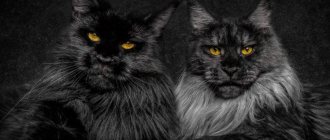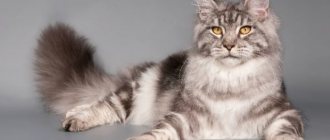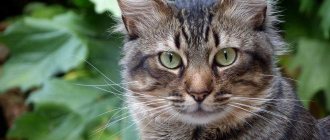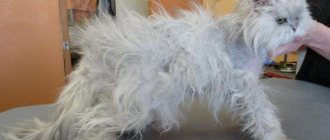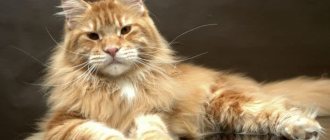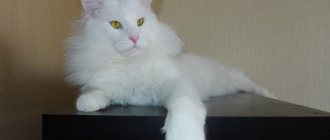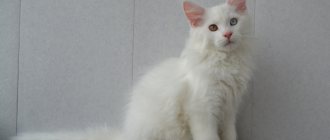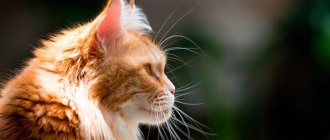Maine Coons come in shorthair, semi-longhair and longhair. Often, owners of this beautiful breed are faced with a problem such as shedding. The problem is quite common and does not always mean that the pet is sick, but it needs to be given special attention.
In most cases, the health of a Maine Coon can be determined by its hair. If the coat is shiny and silky to the touch, then, as a rule, the pet is in good shape and there is no reason to worry.
Molting is a natural process in the life of every animal. But when hair loss occurs on a permanent basis, then most often this phenomenon indicates the presence of some health problems. Often, severe molting signals the development of dangerous pathologies and requires immediate intervention from a specialist.
Causes of increased hair loss
During molting, the Maine Coon gets rid of its old fur, replacing it with a new one. At the same time, the updated “fur coat” helps improve thermoregulation. In fact, there are many more factors influencing hair loss than you might imagine. Let's look at the most common causes of shedding in Maine Coons:
- Improper care;
- Unbalanced diet;
- Frequent stress;
- Seasonality;
- Allergy to anything;
- Hormonal disbalance;
- Viral or infectious diseases;
- Genetic predisposition;
- Environmental influence;
- Pregnancy and lactation;
- Excessively fatty foods.
Shedding can also occur after bathing with various shampoos, gels and balms that may not be suitable for your animal. In this case, dandruff most often appears, the pet begins to itch, and the fur becomes dull, soft and unpleasant to the touch. This problem can be eliminated only by one more bath without using wool products.
Bathing and cosmetics
Frequently washing the Maine Coon is not recommended, since during bathing the protective layer of fat is washed off from the animal’s skin and fur. In addition, many cats do not like to wash themselves and such a procedure is a serious stress for them.
As a rule, Maine Coons are bathed before a show to make the animal look well-groomed and beautiful.
It is necessary to take into account that to bathe your pet you need to use only special products intended for semi-long-haired cats. It is also advisable to select shampoos based on the color of the cat’s coat. In addition to shampoo, you will also need special products: cleansing, degreasing, coloring and texturizing. Without them, the show animal will not look well-groomed, and its coat may appear greasy or bristly.
Procedure
Prepare everything necessary for washing: detergents (shampoo, balm or special paste, texturizer, etc.), a soft cotton towel, cotton swabs to cover the ears or a special plastic collar that protects the cat from getting into the nose, ears and eyes soap suds, and the owners - from being bitten. Place a rubber mat in the bathtub or sink and fill it with warm water (approximately 38 degrees) to 5 - 7 cm. Place cotton swabs in your pet's ears or put a special collar on his neck. Place the cat in the water and, holding the animal firmly by the scruff of the neck with one hand, quickly wet the fur without touching the head. It is most convenient to do this procedure with an assistant. When one person holds a Maine Coon while another person washes the pet. Apply shampoo, lather the animal with it, and then rinse the fur thoroughly. If necessary, this procedure with soaping and rinsing off the shampoo must be repeated. Dry the cat with a towel or, if it is not afraid of noise, dry it with a hairdryer. In any case, until the fur is completely dry, the Maine Coon should not be allowed to roam freely around the house, as the animal may catch a cold due to drafts.
Special products, such as balms, pastes and texturizers, must be used in accordance with the instructions included with them.
Types of shedding
Experts distinguish several main types of shedding in Maine Coons.
Changing baby's fur
The very first moult, as a rule, awaits Maine Coon kittens at the age of 5-6 months, but depending on the physiological characteristics of the pet, the process may begin a little earlier or, conversely, later. In this case, Maine Coon babies change from baby fluff to an adult “fur coat.”
This happens gradually over one to two months. The soft undercoat falls out, and in its place appears a tougher coat, characteristic of an adult healthy Maine Coon. This coat change does not pose a risk to the health of the animal and does not require any treatment.
Seasonal molt
This is an inevitable process that does not depend on the gender, age and color of the Maine Coon. In nature, cats change their fur twice a year - in spring and autumn. Pets that do not have access to walking may shed 3 times a year - in summer, autumn, spring. There is no cause for concern if the coat change lasts from two weeks to 1.5 - 2 months. If the molting is prolonged, then this may already signal deviations.
Apartment molt
This is one of the most common types of shedding in Maine Coons living in apartment conditions without the opportunity to walk in the fresh air. This is due to the fact that the pet ceases to feel seasonality, due to which the cycle of seasonal coat change is disrupted.
Often the situation is aggravated during the heating season or, conversely, in the summer, when the apartment is cooled using climate control equipment (air conditioners, split systems, etc.).
In this case, intensive care and consultation with a specialist on selecting a course of therapy are necessary. Medicines most likely will not be required, but you cannot do without vitamin complexes.
Hair loss due to any disease
Any disease is almost always accompanied by hair loss. This may be the result of ailments such as allergies, viral or infectious diseases, poisoning, gastrointestinal disorders, hormonal imbalance, etc.
This type of shedding can be recognized by several symptoms - depression, diarrhea, loss of appetite, lethargy, the animal sleeps most of the time and looks very depressed. This shedding will continue until the animal recovers.
If a Maine Coon's hair does not fall out evenly, but in patches, then this may be a consequence of allergies, ringworm and other skin diseases. You should not hope for self-healing; in this case, you cannot do without a doctor. Moreover, the sooner you contact him, the faster the animal will return to normal. Treatment usually involves drug therapy.
Improper care
This is the most common cause of year-round and debilitating shedding in Maine Coons. The animal feels well, there are no symptoms that could indicate any disease. The pet has an excellent appetite and a playful mood, but the coat is in poor condition. The problem will continue until the animal is properly cared for.
Molting as a result of stress
Despite the fact that Maine Coons are cats with a stable psyche, they are susceptible to stress just like any other breed. This may be the primary cause of excessive hair loss. Most often, this phenomenon is associated with moves, exhibitions, the appearance of new animals in the house, and other things.
The duration of such a moult depends on how quickly the Maine Coon gains peace of mind. In this case, the owner needs to pay special attention to the behavior of the animal, provide it with a favorable atmosphere, and, if necessary, begin a course of therapy with sedatives, for example, “Vetspokain”, “Cat Bayun”, etc.
Note. If shedding continues for more than two months, then this is a clear signal that it is time to see a doctor. There is no point in delaying the process, as every day the animal’s condition can only worsen.
Maine Coon sheds a lot
| It happens that your cat, regardless of its breed, sheds more than usual. Having experience of keeping 3 cheerful Maine Coons for 5 years, I can say that shedding once a year is a mandatory procedure for each of my animals. | Queen of beauty:) |
The molting of a coon, of course, looks impressive: feathers are pouring out from the lush tail in different directions, not a trace remains of the mane, the sides are losing weight before our eyes, rapidly losing fullness due to the decreasing volume of fur, and this fur itself is no longer just in the soup and bed, but even in a freshly opened carton of milk.
However, it happens that the coon sheds not seasonally, but somehow suddenly. It seems like it’s time for the shedding to end, but the fur is still flying, the nerves are getting worse, the cat looks like a runt.
Causes of heavy shedding in Maine Coons
| 4.5 years, at the beginning of molting |
|
| Always a beauty! |
|
How to find out the reason? If you have already thrown away your cat shampoos that you bought for the occasion at the nearest supermarket, you regularly comb and bathe your animal, make sure that after washing the fur is soft, shiny and free of dandruff, and the cat is still mangy - it’s time to visit the veterinarian, pass banal blood tests (BAC and biochemistry), poop tests for digestibility and assess the general condition of the animal (when the eyes are running, the nose is sneezing, and diarrhea happens once every three days - you shouldn’t dream of a good coat either). Here we will pay attention to the food, yes. The quality of food and the attitude of your cat’s body towards it is half the success.
| Know that initiative is only allowed in choosing shampoo. In winter, when the air in apartments is dry, it is better to take moisturizing shampoos, use liquid silk or moisturizing sprays for wool. Remember that show grooming, which includes treatment with degreasing pastes and shampoos and heavy artillery in the form of volumizing conditioners, is not needed in everyday life. All this is good for three days - just enough for the exhibition, and then the wool sticks together and turns into cotton wool with tangles. Especially if you do not know how to properly wash your animal, do not use exhibition cosmetics, use series for daily care. | Kitten 4 months |
In other matters such as:
- nutrition adjustment and feed selection;
- transition to natural food;
- choice of vitamins and supplements;
- taking medications - experiments are strictly prohibited.
If you want to change food, pick up vitamins, and you definitely see that it would be a good idea to check the animal’s health, go to the veterinarian, call your breeder, read literature and forums, and only then act, constantly monitoring the condition of the animal and its fur.
Cats shedding is common. You and I also shed everything - look at the comb. We just wash every day, know exactly which shampoo is right for us, eat right and take care of ourselves in every possible way.
From experience, sterilized animals shed much less often. Our Ninel is the goddess of beauty and her coat looks great all year round. Pheromone is a beauty from May to the end of November. The rest of the time it’s bald as hell, regardless of the food, the availability of ladies for love and the quality of the wash. Jojo, despite giving birth, is practically in one pore - the tail is beautiful, the hands are huge, the belly is shaggy, and she never had a mane.
And also, so that I don’t have fur EVERYWHERE in my house – I just clean it every day.
kingpraud.ru
When should you contact a veterinarian?
It is especially dangerous when Maine Coon hair loss is accompanied by any symptoms - a sudden change in behavior, elevated body temperature, refusal of food and water, lethargy, diarrhea, vomiting, etc. This almost always indicates the development of dangerous diseases. In this case, it is necessary to take all possible measures to eliminate the disease.
If you do not consult a doctor in time, you can start the disease, which often leads to irreversible consequences and the pathology transitioning to the chronic stage. The first thing the owner should do is contact a veterinarian as soon as possible for diagnostic measures.
Fighting tangles
It is easier to prevent tangles from forming than to try to get rid of them.
That is why periodic brushing, during which matted hair is removed, is necessary for cats of this breed.
If tangles do form, you can try to separate them with your hands or comb them with a comb, trying not to cause pain to the animal.
If the cat is worried, and the tangles cannot be combed or unraveled, then nothing can be done: they will have to be cut off.
In especially advanced cases, if the fur has become matted in many tangles, experts even recommend not torturing your pet with useless attempts to comb them, but to cut it with a clipper. However, it should be remembered that such a haircut is a forced measure and cannot be carried out without a significant reason, since having lost its luxurious coat, the Maine Coon may begin to freeze or begin to have problems with the skin or growing hair, the texture of which may change. - haircuts will change irrevocably.
You should not wet matted wool with water, as this will only make the tangles denser, so that it will be difficult to cut them out.
Elimination methods
Methods for eliminating the disease depend directly on the type of shedding in the Maine Coon. First you need to determine why this problem arose. Most likely, you will need the help of a specialist, since it is not always possible to identify the cause on your own. If the animal feels well with hair loss, then you can try to fix the problem at home.
There are several effective methods that any owner can do. These same measures can be an excellent preventive measure to prevent the problem from recurring.
- Review your pet's diet. Nutrition should be balanced and of high quality. Exclude fatty foods from your Maine Coon's menu, as it can cause not only hair loss, but also cause the development of diseases of the liver, kidneys, gastrointestinal tract and other vital organs. If the Maine Coon eats premium or super-premium food, then additional vitamins are not required. In the case of natural nutrition (meat, chicken, vegetables, cottage cheese, etc.), vitamin complexes should be added to food daily, since it is extremely difficult for an inexperienced person to properly balance the diet and create a competent daily menu.
- If the cause of shedding in a Maine Coon cat is hormonal changes, such as estrus, then spaying the cat will be necessary to correct the problem. There is no other way to get rid of severe hair loss even with the help of the most expensive vitamin complexes.
- Provide your Maine Coon with proper care. In order for the coat to be beautiful and healthy, it is necessary to properly care for it. If you don’t have time to brush your pet every day, then this should be done at least 2-3 times a week. Cats are often not allowed to be bathed, but brushing can be done using special dry shampoos. In this case, it needs to be selected according to the type and color of the coat so that the product suits the animal as best as possible. Dry shampoo is best used once every 14-21 days. You should not use it more often, as this may cause dandruff.
- During seasonal molting and the change from baby to adult fur, it is necessary to help the animal. Combing should be done daily, without using any products. If you do not care for your pet during this period, then, as a rule, this leads to the formation of painful tangles and prolonged molting.
- If the Maine Coon does not have access to walking outside, then it is necessary to ventilate the room more often. If the air in the apartment is dry, you need to humidify it using special humidifiers.
- If shedding is caused by any disease, you must consult a doctor to eliminate the underlying cause. Without a competent prescription, the problem will not disappear on its own. In addition, lack of treatment often leads to the development of complications, which can subsequently cause death. Once the disease is eliminated, the coat problem will most likely be resolved.
- It is important to monitor your emotional state. Avoid stressing the animal, provide it with the necessary household items - toys, a scratching post, a personal bed. Catnip is good for preventing stress. You can buy it at any pet store. You can spray a catnip-based spray on your scratching post or bed once a day for a week.
- The main vitamins that help with molting are B2 and B5, as well as biotin. Therefore, they must be present in vitamin complexes. In addition, the presence of components such as sulfur, iodine and seaweed extract will not hurt. Vitamins “8 in 1 Excel Brewers” are often used for Maine Coons. They are intended for dogs, but this should not alarm the owner. The vitamins are very suitable for Maine Coon cats. Recommended course is 10-14 days, 1 tablet per day per 4 kg of animal weight. If the cat weighs 8 kg, then the daily norm is 2 tablets.
- Since biotin is responsible for the health of the coat, a lack of it can lead to severe shedding. To compensate for the lack of this component in the Maine Coon's body, it is necessary to give raw egg yolk (without white) 1-2 times a week. There is an opinion that quail eggs are better for Maine Coons, but in fact, both are equally useful.
Important! Any self-medication can only aggravate the situation and significantly worsen the pet’s condition. Give any medications only after consulting a doctor.
A healthy, beautiful coat is the Maine Coon’s pride, but in order for it to always be in good shape, the pet needs help in caring for it. In addition, it is important to remember that it is easier to prevent any disease than to eliminate its serious consequences later. If you follow all the necessary preventive measures and recommendations of specialists, then the risk of problems is reduced to almost zero.
How to care for Maine Coon fur
Everyday care for your pet's coat includes several steps that require little time and minimal preparation.
Combing
To brush your cat you will need 2 combs:
- with sparse, long teeth will easily remove tangled hairballs;
- with frequent but shorter teeth will remove the remains of fallen hair and dirt.
Combing is carried out from the back of the head towards the tail.
You should not buy:
- furminator, designed for grooming dogs;
- slicker, as it can cause microtrauma and severe pain to the pet.
It is also allowed to use rotating comb brushes with rounded metal teeth to care for a cat's fur: they are well suited for combing very long hair that is prone to tangles.
During non-shedding periods, it is recommended to use the comb twice a week.
Bathing and cosmetics
When swimming, you should adhere to a number of rules:
- heat the water to 38 degrees;
- protect the bathroom from drafts;
- Place a small towel at the bottom of the bath and constantly stroke your pet - this will reduce stress levels;
- Do not allow water to get into the cat’s ears and eyes.
You should bathe your pet during shedding, to facilitate it, and during the recovery period after diseases that did not allow the animal to fully care for its coat on its own.
During bathing, special shampoos for long-haired pets are used. Finally, the fur coat is rinsed with good pressure of warm water in the direction of hair growth.
The washed pet should be carefully dried with a soft towel - active friction can greatly tangle the wet fur. If the animal is in the period of molting, it should be dried with a hairdryer; in other cases, the cat should be allowed to lick itself. And only after that you can comb the Maine Coon with a comb.
Fighting tangles
It is not recommended to untangle the tangles found by hand or with a comb; they must be carefully cut out with nail scissors. Most often, the hair gets very tangled in the tail, belly, neck and hind legs.
The main cause of tangles is a skin fungus, which is easily identified by the presence of dandruff. In such a case, it is necessary to visit a veterinary clinic so that a specialist can prescribe antifungal therapy. To prevent the appearance of tangles, it is recommended not to forget about regular use of a comb.
Poor nutrition, lack of hygiene and deteriorating health primarily affect the condition of the animal's coat: it becomes brittle, loses its shine and falls out. To avoid negative consequences, you should carefully monitor your pet’s diet, do not neglect the described rules of care, and conduct preventive examinations with a veterinarian.
Did you like the article?

